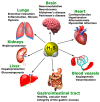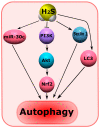The Role of Hydrogen Sulfide in Regulation of Cell Death following Neurotrauma and Related Neurodegenerative and Psychiatric Diseases
- PMID: 37445920
- PMCID: PMC10341618
- DOI: 10.3390/ijms241310742
The Role of Hydrogen Sulfide in Regulation of Cell Death following Neurotrauma and Related Neurodegenerative and Psychiatric Diseases
Abstract
Injuries of the central (CNS) and peripheral nervous system (PNS) are a serious problem of the modern healthcare system. The situation is complicated by the lack of clinically effective neuroprotective drugs that can protect damaged neurons and glial cells from death. In addition, people who have undergone neurotrauma often develop mental disorders and neurodegenerative diseases that worsen the quality of life up to severe disability and death. Hydrogen sulfide (H2S) is a gaseous signaling molecule that performs various cellular functions in normal and pathological conditions. However, the role of H2S in neurotrauma and mental disorders remains unexplored and sometimes controversial. In this large-scale review study, we examined the various biological effects of H2S associated with survival and cell death in trauma to the brain, spinal cord, and PNS, and the signaling mechanisms underlying the pathogenesis of mental illnesses, such as cognitive impairment, encephalopathy, depression and anxiety disorders, epilepsy and chronic pain. We also studied the role of H2S in the pathogenesis of neurodegenerative diseases: Alzheimer's disease (AD) and Parkinson's disease (PD). In addition, we reviewed the current state of the art study of H2S donors as neuroprotectors and the possibility of their therapeutic uses in medicine. Our study showed that H2S has great neuroprotective potential. H2S reduces oxidative stress, lipid peroxidation, and neuroinflammation; inhibits processes associated with apoptosis, autophagy, ferroptosis and pyroptosis; prevents the destruction of the blood-brain barrier; increases the expression of neurotrophic factors; and models the activity of Ca2+ channels in neurotrauma. In addition, H2S activates neuroprotective signaling pathways in psychiatric and neurodegenerative diseases. However, high levels of H2S can cause cytotoxic effects. Thus, the development of H2S-associated neuroprotectors seems to be especially relevant. However, so far, all H2S modulators are at the stage of preclinical trials. Nevertheless, many of them show a high neuroprotective effect in various animal models of neurotrauma and related disorders. Despite the fact that our review is very extensive and detailed, it is well structured right down to the conclusions, which will allow researchers to quickly find the proper information they are interested in.
Keywords: anxiety disorders; apoptosis; autophagy; cognitive impairment; depression; encephalopathy; epilepsy; ferroptosis; glial cells; hydrogen sulfide; neurodegenerative diseases; neuron; neurotrauma; pyroptosis.
Conflict of interest statement
The authors declare no conflict of interest.
Figures











Similar articles
-
Critical role of hydrogen sulfide in the management of neurodegenerative disease.Nitric Oxide. 2025 Feb;154:77-85. doi: 10.1016/j.niox.2024.11.006. Epub 2024 Nov 20. Nitric Oxide. 2025. PMID: 39577488 Review.
-
Potential for therapeutic use of hydrogen sulfide in oxidative stress-induced neurodegenerative diseases.Int J Med Sci. 2019 Sep 20;16(10):1386-1396. doi: 10.7150/ijms.36516. eCollection 2019. Int J Med Sci. 2019. PMID: 31692944 Free PMC article. Review.
-
Brain, Learning, and Memory: Role of H2S in Neurodegenerative Diseases.Handb Exp Pharmacol. 2015;230:193-215. doi: 10.1007/978-3-319-18144-8_10. Handb Exp Pharmacol. 2015. PMID: 26162836 Review.
-
A new hope for neurodegeneration: possible role of hydrogen sulfide.J Alzheimers Dis. 2011;24 Suppl 2:173-82. doi: 10.3233/JAD-2011-110128. J Alzheimers Dis. 2011. PMID: 21441657 Review.
-
Therapeutic benefits of H₂S in Alzheimer's disease.J Clin Neurosci. 2014 Oct;21(10):1665-9. doi: 10.1016/j.jocn.2014.01.006. Epub 2014 Jun 2. J Clin Neurosci. 2014. PMID: 24882562 Review.
Cited by
-
Cellular preconditioning and mesenchymal stem cell ferroptosis.World J Stem Cells. 2024 Feb 26;16(2):64-69. doi: 10.4252/wjsc.v16.i2.64. World J Stem Cells. 2024. PMID: 38455100 Free PMC article.
-
The Role of Hydrogen Sulfide in the Localization and Expression of p53 and Cell Death in the Nervous Tissue in Traumatic Brain Injury and Axotomy.Int J Mol Sci. 2023 Oct 28;24(21):15708. doi: 10.3390/ijms242115708. Int J Mol Sci. 2023. PMID: 37958692 Free PMC article.
-
The Role of Hydrogen Sulfide in the Localization and Structural-Functional Organization of p53 Following Traumatic Brain Injury: Development of a YOLO Model for Detection and Quantification of Apoptotic Nuclei.Int J Mol Sci. 2025 May 24;26(11):5066. doi: 10.3390/ijms26115066. Int J Mol Sci. 2025. PMID: 40507878 Free PMC article.
-
Efficacy and safety of Perampanel in the treatment of post stroke epilepsy: A multicenter, real-world study.Heliyon. 2024 Feb 21;10(5):e26376. doi: 10.1016/j.heliyon.2024.e26376. eCollection 2024 Mar 15. Heliyon. 2024. PMID: 38434369 Free PMC article.
-
Hydrogen Sulfide: An Emerging Regulator of Oxidative Stress and Cellular Homeostasis-A Comprehensive One-Year Review.Antioxidants (Basel). 2023 Sep 7;12(9):1737. doi: 10.3390/antiox12091737. Antioxidants (Basel). 2023. PMID: 37760041 Free PMC article. Review.
References
-
- Laskowitz D., Grant G.E. Translational Research in Traumatic Brain Injury. CRC Press; Boca Raton, FL, USA: 2016. - PubMed
-
- Rodkin S.V., Dzreyan V.A., Demyanenko S.V., Uzdensky A.B. The Role of p53-Dependent Signaling Pathways in Survival and Death of Neurons and Glial Cells after Peripheral Nerve Injury. Biochem. (Moscow) Suppl. Ser. A Membr. Cell Biol. 2021;15:334–347. doi: 10.1134/S199074782106009X. - DOI
Publication types
MeSH terms
Substances
Grants and funding
LinkOut - more resources
Full Text Sources
Medical
Miscellaneous

